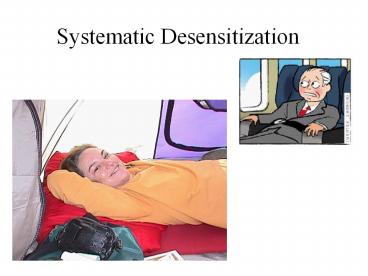Systematic Desensitization - PowerPoint PPT Presentation
Title:
Systematic Desensitization
Description:
Systematic Desensitization SD vs. Modeling or Cognitive Interventions? When a client has the skills but avoids the situation due to anxiety. If a person avoids a ... – PowerPoint PPT presentation
Number of Views:827
Avg rating:3.0/5.0
Title: Systematic Desensitization
1
Systematic Desensitization
2
SD vs. Modeling or Cognitive Interventions?
- When a client has the skills but avoids the
situation due to anxiety. - If a person avoids a situation because of skill
deficits, then SD is inadequate
3
SD vs. Modeling or Cognitive Interventions?
- People with many fears or with general, pervasive
anxiety may benefit more from cognitive change
strategies or from combinations of strategies in
which desensitization may play some role. - Desensitization should not be used when the
client's anxiety is nonspecific, or
free-floating. - Desensitization is appropriate for problems in
which there is a strong conditioned emotionlike
anger or grief.
4
Major steps in Systematic Desensitization
- Rationale
- Assessment
- Identification of Emotion-Provoking situations
- Imagery Assessment
- Intervention
- Hierarchy Construction
- Selection and Training of Counter-conditioning or
Coping Response - Scene Presentation
- Homework and Follow-Up
5
Rationale
- Reason for treatment and why it works
- Description of procedure
- Check for permission
6
Imagery Assessment
- Is the image concrete, with sufficient detail and
evidence of touch, sound, smell, and sight
sensations. - Is the client a participant, not an observer.
- Can the client switch a scene image on and off
upon instruction. - Can the client hold a particular scene without
drifting off or changing the scene.
7
Methods of identification of emotion- provoking
situations
- Interview assessment
- Client self-monitoring
- Self-report questionnaires
8
Three types of hierarchies
- Spatio-temporal Hierarchy
- Thematic Hierarchy
- Personal Hierarchy
9
Appropriate Hierarchy Items
- Some of the items are under the client's control
- An item must be concrete and specific.
- Obtain a clear and vivid visualization of the
item during scene presentation. - Not "your best friend disapproves of you
- Better "Your best friend disapproves of your
boyfriend and tells you that you are stupid for
going out with him."
10
Coping Response
- Relaxation
- Emotive Imagery
- Meditation
11
Criteria for Appropriate Hierarchy Items
- Similar to situations the client has or may have
to face. - Adapt dialogue to the client.
- Reflect a broad range of situations in which the
client's fear (or other emotion) does or could
occur. - Items should reflect all different levels of the
emotion, ranging from low to high intensity.
12
Hierarchy Scene Presentation
- Imagine scene 20 to 40 seconds
- When anxiety is felt
- Hold image
- Relax away tension
13
Homework
- Daily practice
- Visualization of previously successful items
- Practice in vivo
- Completion of log sheet
14
Systematic Desensitization
- 1. Rationale
- 2. Identification Emotion-Provoking Situations
- 3. Hierarchy Construction
- 4. Selection and Training of Counter-conditioning
or Coping Response - 5. Imagery Assessment
- 6. Hierarchy Scene Presentation
- 7. Homework follow-up.































